Sussex Yeomanry
| Sussex Yeomanry | |
|---|---|
| Active | 1794 - today |
| Country |
|
| Branch |
|
| Type | Yeomanry |
| Role |
Cavalry Field Artillery |
| Size | Regiment |
| Engagements |
|
The Sussex Yeomanry is a yeomanry regiment of the British Army formed in 1794. It was initially formed when there was a threat of French invasion during the Napoleonic Wars. After seeing action in the Second Boer War, it served in the First World War and the Second World War, when it served in the East African Campaign and the Siege of Tobruk. The lineage is maintained by 1 (Sussex Yeomanry) Field Troop, 579 Field Squadron (EOD), part of 101 (London) Engineer Regiment (Explosive Ordnance Disposal) (Volunteers).
Formation and early history
In 1793, the prime minister, William Pitt the Younger, proposed that the English Counties form a force of Volunteer Yeoman Cavalry that could be called on by the king to defend the country against invasion or by the Lord Lieutenant to subdue any civil disorder within the country.[1] The Sussex Troops of Gentlemen and Yeomanry Cavalry was formed at Petworth in 1794 but disbanded in 1828.[2] It was raised for a second time as the Sussex Yeomanry Cavalry in 1831 and disbanded in 1848; it was then raised for a third time as the 1st Sussex Light Horse Volunteer Corps in 1871 and disbanded in 1875.[2]
Second Boer War
The Sussex Imperial Yeomanry was formed 14 June 1901 as one of the Imperial Yeomanry regiments created to serve in the Second Boer War in South-Africa.[3] It was based at the drill hall in Church Street in Brighton.[4]
World War I
| South Eastern Mounted Brigade |
|---|
|
Organisation on 4 August 1914 |
|
Assigned units
|
|
Training attachments
|
|
In accordance with the Territorial and Reserve Forces Act 1907 (7 Edw. 7, c.9) which brought the Territorial Force into being, the TF was intended to be a home defence force for service during wartime and members could not be compelled to serve outside the country. However, on the outbreak of war on 4 August 1914, many members volunteered for Imperial Service. Therefore, TF units were split in August and September 1914 into 1st Line (liable for overseas service) and 2nd Line (home service for those unable or unwilling to serve overseas) units. Later, a 3rd Line was formed to act as a reserve, providing trained replacements for the 1st and 2nd Line regiments.[5]
1/1st Sussex Yeomanry
The 1st Line regiment was mobilised on 4 August 1914 at the outbreak of the First World War and was in the Canterbury area (under Second Army of Central Force[6]) until September 1915.[7] It was dismounted and left Kent for Liverpool; on 24 September it boarded RMS Olympic and sailed the next day. It arrived at Lemnos on 1 October. The regiment landed in Gallipoli on 8 October and was attached to the 42nd (East Lancashire) Division.[8] Within days of the landing the Regiment reported many men suffering from enteritis. While at Gallipoli they spent time in the trenches at Border Barricade and Fusilier Bluff. On 30 December it was evacuated to Mudros with 42nd Division; it left the Division at Mudros on 2 January 1916.[9]
The brigade, with the regiment, was withdrawn to Egypt in February 1916[7] and formed part of the Suez Canal Defences. On 22 February, South Eastern Mounted Brigade was absorbed into the 3rd Dismounted Brigade (along with the Eastern Mounted Brigade).[9] The brigade served as part of the Suez Canal Defences from 14 March to 26 July attached to 42nd (East Lancashire) Division;[9] it then joined the Western Frontier Force.[10] By the end of the year, it was back on the Suez.[11]
The brigade was with the Suez Canal Defences when, on 14 January 1917, Egyptian Expeditionary Force (EEF) Order No. 26 instructed that the 2nd, 3rd and 4th Dismounted Brigades be reorganized as the 229th, 230th and 231st Brigades.[11] The brigade units were reorganized in January and February 1917. As a result, the 1/1st Sussex Yeomanry was converted to infantry at Mersa Matruh[12] on 3 January 1917 and redesignated 16th (Sussex Yeomanry) Battalion, Royal Sussex Regiment.[13]
On 23 February, the GOC EEF (Lt-Gen Sir A.J. Murray) sought permission from the War Office to form the 229th, 230th and 231st Brigades into a new division. The War Office granted permission and the new 74th (Yeomanry) Division started to form. The 230th Brigade joined the division at Deir el Balah between 9 and 13 April.[11] The battalion remained with 230th Brigade in 74th (Yeomanry) Division for the rest of the war.[14]
With the 74th Division, the battalion took part in the invasion of Palestine in 1917 and 1918. It fought in the Second and Third Battles of Gaza (including the capture of Beersheba and the Sheria Position). At the end of 1917, it took part in the capture and defence of Jerusalem and in March 1918 in the Battle of Tell 'Asur. On 3 April 1918, the Division was warned that it would move to France and by 30 April 1918 had completed embarkation at Alexandria.[11]
In May 1918, the battalion landed at Marseilles, France with 74th (Yeomanry) Division. It served in France and Flanders with the division for the rest of the war. By 18 May, the division had concentrated around Rue in the Abbeville area. Here the dismounted Yeomanry underwent training for service on the Western Front, particularly gas defence.[14]
On 14 July 1918 the Yeomanry Division went into the line for the first time, near Merville on the right of XI Corps. From September 1918, as part of III Corps of Fourth Army, it took part in the Hundred Days Offensive including the Second Battle of the Somme (Second Battle of Bapaume) and the Battles of the Hindenburg Line (Battle of Épehy). In October and November 1918 it took part in the Final Advance in Artois and Flanders. By the Armistice it was near Tournai, Belgium, still with 74th (Yeomanry) Division.[14]
With the end of the war, the troops of 74th Division were engaged in railway repair work and education was undertaken while demobilisation began. The division and its subformations were disbanded on 10 July 1919.[14]
2/1st Sussex Yeomanry
The 2nd Line regiment was formed at Brighton in September 1914 and remained there until May 1915. It then moved to Maresfield and joined 2/1st South Eastern Mounted Brigade; there it took over the horses of 2nd King Edward's Horse who were going dismounted to the Western Front. In October 1915 the regiment was at Canterbury.[7] On 31 March 1916, the remaining Mounted Brigades were ordered to be numbered in a single sequence;[15] the brigade was numbered as 14th Mounted Brigade and joined 4th Mounted Division.[7]
In July 1916, 4th Mounted Division became 2nd Cyclist Division and the regiment was converted to a cyclist unit in 5th Cyclist Brigade at Great Bentley. In November 1916 the division was broken up and the regiment was merged with the 2/1st Surrey Yeomanry to form 8th (Surrey and Sussex) Yeomanry Cyclist Regiment in 3rd Cyclist Brigade at Ipswich. In March 1917 it resumed its identity as 2/1st Sussex Yeomanry at Ipswich, and later moved to the Woodbridge area. In April 1918, the regiment moved with 3rd Cyclist Brigade to Ireland, landing in Dublin on 21 April. Initially it was stationed at Clandeboye and in September 1918 to Boyle; there was no further change before the end of the war.[7]
3/1st Sussex Yeomanry
The 3rd Line regiment was formed in July 1915 at Brighton and affiliated to the 3rd Reserve Cavalry Regiment at Canterbury. In the summer of 1916 it was dismounted and attached to the 3rd Line Groups of the Home Counties Division at Crowborough as its 1st Line was serving as infantry. The regiment was disbanded in January 1917 with personnel transferring to the 2nd Line regiment or to the 4th (Reserve) Battalion of the Royal Sussex Regiment at Tunbridge Wells.[7]
Between the wars
After World War I the TF was reformed as the Territorial Army (TA). The 14 senior Yeomanry regiments remained horsed cavalry regiments (6 forming the 5th and 6th Cavalry Brigades) while the remaining Yeomanry Regiments were reassigned as artillery. In 1920 the regiment reformed as the 13th (Sussex Yeomanry) Army Brigade, Royal Field Artillery (RFA), but in 1921 this was redesignated 98th (Sussex Yeomanry) Brigade, RFA. Then in 1922 it amalgamated with two batteries newly converted from the Surrey Yeomanry to form 98th (Surrey and Sussex Yeomanry) Brigade, Royal Field Artillery with 389 and 390 (Sussex Yeomanry) Field Batteries, and 391 and 392 (Surrey Yeomanry) Field Batteries. In 1924 it was redesignated 98th (Surrey and Sussex Yeomanry, Queen Mary's) Army Field Brigade, Royal Artillery, and the Regimental Headquarters moved from Brighton to Clapham Park. The regiment was among the 'Army Troops' administered by 44th (Home Counties) Infantry Divisional Area. When the TA was doubled in size following the Munich Crisis, 389 and 390 (Sussex Yeomanry) Batteries left to form a duplicate regiment, 144th Field Regiment, RA at Brighton in 1939. Both regiments were considered to be 'Surrey & Sussex Yeomanry', and 144th received the 'Surrey and Sussex Yeomanry, Queen Mary's' subtitle in 1942.[2][16][17][18][19][lower-alpha 2]
World War II
98th Field Regiment (Surrey & Sussex Yeomanry Queen Mary's)
- See main article 98th Field Regiment (Surrey & Sussex Yeomanry Queen Mary's)
On mobilisation in 1939, the Regiment was part of the British Expeditionary Force (B.E.F.) that was sent to France, initially attached to the 1st Infantry Division in the Lille area. In May 1940 it would be attached in turn to the 46th and 44th Infantry Divisions during the German advance the regiments Guns and vehicles were caught in a traffic jam and had to be destroyed, with the troops proceeding on foot to Dunkirk for evacuation.[21] Back in the United Kingdom the regiment was attached to the 1st Infantry Brigade while it reformed it remained in the United Kingdom until September 1942 when it was sent out to the Middle East and attached to the 10th Armoured Division in Egypt where it participated in the Second Battle of El Alamein, when 10th Armoured was disbanded the regiment was part of the 8th Army Artillery and served in Sicily and Italy being involved in the Battle of Monte Cassino amongst others before leaving Italy in March 1945 and joining the 2nd Army in France and Belgium ending the war in the Netherlands. In April 1945 the Regiment moved to the Lübeck area of Germany as occupation forces and demobilisation was started in October 1945 with the Regiment being placed in suspended animation in June 1946.[21]
144th Field Regiment (Surrey & Sussex Yeomanry Queen Mary's)
Home Defence
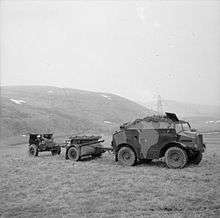
On the outbreak of war in September 1939 the regiment mobilised at Brighton as an Army field regiment in Eastern Command. It was equipped with 12 x 4.5-inch howitzers of World War I vintage, but within days it had handed over eight of these guns to 123 Officer Cadet Training Unit at Catterick Garrison and all its vehicles to 98th (S&SY) Fd Rgt, which was preparing to go to France with the British Expeditionary Force (BEF). In the following weeks the regiment received 18 x 18-pounder Mk II guns, and 15 assorted civilian vehicles. In April 1940, 144th Fd Rgt went to Dursley in Gloucestershire to join IV Corps, and began to receive modern 25-pounder guns and Quad tractors. By June, when the BEF had been evacuated from Dunkirk without any of its guns, 144th Fd Rgt was one of the few field regiments in the UK with its full allotment of 24 x 25-pounders. It was attached to the Regular Army 4th Division, which was refitting in Hampshire, before returning to IV Corps in August.[19][22]
East Africa
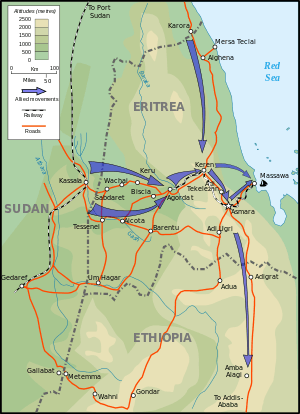
After Italy declared war in the summer of 1940, the War Office sent reinforcements to protect the British bases in Egypt, the convoys taking the longer but safer round the Cape of Good Hope to the Red Sea ports. These reinforcements included three field regiments sent before the end of 1940, including 144th (S&SY). On 16 November the regiment under Lt-Col H.T.W. Clements landed at Suez, and by 8 December it been taken back to Port Sudan to join 5th Indian Division at Haiya in the Sudan.[19][20][23][24][25][26][27][28]
On arrival, 390 Bty (less F Troop) under the command of Major E.C.R. Mansergh, was sent to Mekali Wells to join 'Gazelle Force' on 11 December. Organised around the divisional motor cavalry regiment (Skinner's Horse) and two motor machine gun companies of the Sudan Defence Force, Gazelle Force under the command of Colonel Frank Messervy had been raiding Italian frontier posts since October, and 390 Bty's 25-pounders replaced an earlier battery of 18-pounders. F Troop, which had been detached to Gebeit, rejoined 390 Bty on 17 January.[19][23][29][30]
In January 1941 the British force advanced against Kassala and the Italians withdrew. Gazelle Force was sent in pursuit. On 21 January it was approaching Keru when D and F Troops of 390 Bty were charged by about 60 Eritrean cavalry led by two Italian officers on grey horses – probably the last time British forces faced a cavalry charge. The horsemen were driven off by the guns firing over open sights and gunners of 25th Fd Rgt using rifles. The battery's observation posts (OPs) also drove off enemy infantry and dismounted cavalry who were working round the position. After the enemy had been winkled out of Keru Gorge, a three-day fight for Agordat followed, with the guns supporting infantry fighting their way up steep hills. By 1 February the advance was continuing at high speed, the guns driving at 35 mph until they were stopped by artillery fire 1 mile (1.6 km) short of Ponte Mussolini on the Barka River. E Troop unlimbered and put the Italian guns out of action with seven rounds. On 3 February the battery reached the main Italian defensive position at Dongolass Gorge that shut off the Keren Plateau and began shelling the defences.[19][23][31][32]
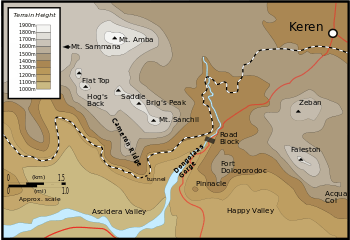
Reinforced, Gazelle Force attempted to seize the gorge by scaling the heights either side of it. A company of 2nd Battalion, Queen's Own Cameron Highlanders, accompanied by a Forward Observation Officer's (FOO) party from 390 Bty, scaled Point 1616 (later known as Cameron Ridge), pushing off defenders of the Savoia Grenadiers. The eight-week Battle of Keren followed. The steep mountainsides caused problems for the OPs and the guns. 'Brig's Peak' and 'Acqua Col' were unsuccessfully attacked. On 10 February the 4/6th Rapjputana Rifles (the 'Rajrifs') made another assault on the Acqua Col, Major Mansergh and his party going up with the battalion HQ. Despite the battery firing 2816 rounds in the day, the opposition proved too strong for the Rajrifs.[33][34][35]
Meanwhile the rest of the regiment with 5th Indian Division had been fighting hard for Barentu, until the defenders withdrew after the fall of Agordat. Now the force was concentrated to take Keren and regiment was reunited.[19][36][37][38] The regiment came into action in the Hagas Valley at 20.30 on 14 February. All the artillery of two divisions was concentrated against Mount Sanchil on 16 March, and the OP on Cameron Ridge was able to bring down F Trp's fire on enemy reinforcements massing for a counter-attack. That night the OP reported the British and Indian troops were only yards for their objectives. F Troop tried to silence the enemy mortars and 390 Bty continued firing against divisional targets all next day. On 18 March the OP reported that the enemy had recaptured Sanchil, and at 05.15 the next morning the Alpini battalion of the Savoia Grenadiers was seen running down the gorge, until an effective Defensive Fire (DF) task was called down on them.[36][39][40]
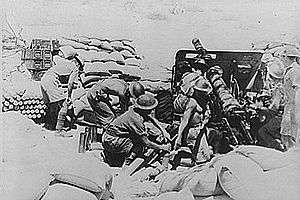
Meanwhile 389 Bty under Major A.G. Munn was supporting Brigadier Messervy's attack on Fort Dolgorodoc. Munn accompanied 2nd Bn Highland Light Infantry and was wounded, while his signaller won a Military Medal for laying out a telephone line under fire when the radio failed. 144th Field Rgt was in constant action beating off enemy counter-attacks, but was sustaining casualties from return fire. On 25 March 398 Bty engaged and dispersed a force of enemy tanks, but that day a mobile column broke through the roadblock in the Dongolass gorge and Keren fell two days later.[36][41][42] Afterwards, 144th Fd Rgt was concentrated with 5th Indian Division in the final push on Addis Ababa. At Amba Alagi on 4 May, 29th Indian Infantry Brigade took a series of hill features while covered by a timed artillery fireplan. The following day Major Munn accompanied 1st Bn Worcestershire Regiment as they took Middle Hill supported by a powerful artillery attack. Further advance on this line was impossible, but the main Italian force in East Africa surrendered on 19 May.[43][44][45]
Tobruk
At the end of the campaign, 5th Indian Division returned to Egypt. 144th Field Rgt sailed from for Suez on 24 June, arriving two days later.[19][28][46] In August it was preparing defensive positions at El Alamein. Then in September it came under the direct command of British Troops Egypt, handed in all its guns and equipment at Alexandria, and the personnel were shipped into the besieged port of Tobruk aboard HMAS Nizam and HMAS Napier on 18/19 September in one of the regular night supply runs by the Royal Navy's Inshore Squadron. At Tobruk it was attached to 70th Division, replacing the 9th Australian Division which had garrisoned the place during the first part of the siege.[19][28][47][48]
On arrival the regiment took over an assortment of old guns from 2/12th Australian Fd Rgt, which had been the garrison's primary counter-battery unit:[19][47][49]
- 389 Bty
- A Trp: 4 x 100mm Italian guns (pre-1914)
- B & C Trps: 4.5-inch howitzers (1904 vintage)
- 390 Bty
- D Trp: 18-pounders in the anti-tank (A/T) role
- E Trp: 105mm Italian guns (1914)
- F Trp: 4 x 60-pounders (World War I)
The CO, Lt-Col Clements, described these as 'what must have been the most extraordinary collection of junk with which any British regiment went into battle'.[47] In October there was a rearrangement, with E Trp taking over 4.5-inch, D Trp 100mm, B & C Trps 18-pdrs, and RHQ manning Austrian-made 150mm howitzers.[19]
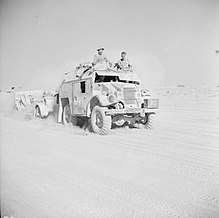
On 21 November, 70th Division began its breakout from Tobruk to link up with Eighth Army's Operation Crusader. 144th Field Rgt's FOOs were able to watch the capture of key enemy positions such as 'Tiger', and to direct the 18-pounders of B and C Trps against enemy A/T guns.[50][51] After hard fighting, covered by 144th Fd Rgt, 70th Division broke through and XIII Corps' HQ entered the town on 29 November. Fighting continued: on 30 November the regiment halted an enemy infantry counter-attack with a DF programme, though one gun of D Trp was knocked out by a direct hit. The full link-up between Eighth Army and the Tobruk garrison was achieved on 5 December, and by 10 December all enemy troops had withdrawn from the perimeter.[52][53]
On 28 January 1942 the regiment came under the command of 4th Indian Division and was re-issued with 25-pdrs. 4th Indian had just retired to the Gazala Line, where Eighth Army dug in during a lull in the fighting.[19][28][54] On 23 February the regiment came under 1st Armoured Division. The Gazala Line was screened by small mobile columns: 390 Bty formed part of one mobile column until April, and 389 Bty joined 'Mooncol' in April. On 27 April the regiment reverted to 5th Indian Division at Sollum.[19][28][55]
Middle East
144th (S&SY) Field Rgt left 5th Indian Division for the last time on 10 May 1942 and was sent to Habbaniyah in Iraq to join Tenth Army. Here it was joined for a month by 103 Bty from 79th A/T Rgt, in an experimental organisation used in the region.[28][56][57][58] On 4 July the regiment was sent to Aleppo in Syria to join 17th Indian Infantry Brigade, and then on 24 August to Persia to join 31st Indian Armoured Division. It moved with the division into Iraq on 20 November.[19][28]
Royal Artillery field regiments had adopted a three-battery organisation earlier in the war, and 144th Fd Rgt finally reorganised its 24 guns into three batteries (389, 390 and 522) in January 1943. In October 1943, 31st Indian Armoured Division moved to Egypt, apparently to join the Italian Campaign, but this never happened. The regiment served for a while as depot regiment at the Middle East School of Artillery at Almaza. It moved to Palestine with 31st Indian Armd Division on 24 February 1944, and received M4 Sherman tanks as OPs. In May 1944 it was the depot regiment at the Mountain Warfare Training Centre at Bsarma in Lebanon. It remained garrisoning Palestine, Lebanon and Syria for the rest of the war – latterly only 390 Bty having guns, the remainder as infantry – and saw no further action.[19][28]
144th (Surrey & Sussex Yeomanry QMR) Field Regiment was placed in suspended animation at Almaza, Egypt, in September 1945.[19][16]
Postwar
When the TA was reconsituted in 1947, the two regiments were reformed as 298th (Surrey Yeomanry, Queen Mary's) Field Regiment, RA and 344th (Sussex Yeomanry) Light Anti-Aircraft Regiment, RA. In 1950 the 344th absorbed 605th (Sussex) Heavy Anti-Aircraft Regiment, RA. On 10 March 1955, Anti-Aircraft Command was disbanded and there was a reduction in the number of TA anti-aircraft units. On that day 344 (Sussex Yeomanry) LAA Rgt merged with 258 (Sussex) LAA Rgt and 313 (Wessex), and 641 (Sussex) Heavy Anti-Aircraft Regiments to form 258 (Sussex Yeomanry) Light Anti-Aircraft Regiment, RA. The former 344 LAA Rgt provided RHQ and P Battery at Brighton to the new regiment. In 1961, this regiment in turn merged with 257 (County of Sussex) Field Rgt to form 257 (Sussex Yeomanry) Field Rgt, with RHQ at Brighton.[16][59][60][61][62]
When the TA was converted into the TAVR in 1967, the regiment was reduced to 200th (Sussex Yeomanry) Medium Battery in 100th (Eastern) Medium Regiment.[2][16][60]
In April 1993, 200 (Sussex Yeomanry) Battery converted to become 127 (Sussex Yeomanry) Field Squadron, 78 (Fortress) Engineer Regiment Royal Engineers.[63] Although the regiment disbanded in 1999, the lineage was maintained by 1 (Sussex Yeomanry) Troop, 579 Field Squadron (EOD), part of 101 (London) Engineer Regiment (Explosive Ordnance Disposal) (Volunteers) at Reigate Army Reserve Centre.[2]
Honorary Colonels
The following served as Honorary Colonel of the unit:[64][65]
- William Nevill, 1st Marquess of Abergavenny 28 September 1901[66]
- St John Brodrick, 1st Earl of Midleton, appointed (to Surrey Yeomanry) 28 September 1901 (joint Hon Col from 1922)
- Charles Wyndham, 3rd Baron Leconfield, appointed (to joint regiment) 13 December 1922
Uniforms and insignia
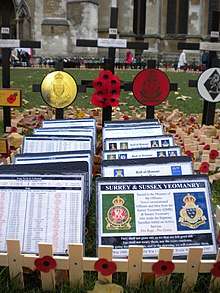
The several units that made up the Sussex Troops of Gentlemen and Yeomanry in 1794, favoured light cavalry helmets with feather plumes, short dark green jackets with black facings and white breeches. The Arundel and Bramber Troop raised in 1831 followed contemporary Light Dragoon fashion with bell-topped shakos, light blue jackets with red facings and plastron, plus white breeches.[67] The newly formed Regiment of Sussex Imperial Yeomanry of 1901 wore khaki for both full and service dress, but in both orders with "Dublin Fusiliers Blue" (a bright shade) for cuffs, collars and trouser stripes. Blue Lancer style plastrons were worn for parade and off duty wear. The headdress for all ranks was a Boer War influenced slouch hat of light drab with bright blue emu feather plumes. In 1909 the khaki full dress was replaced by a bright blue 'Indian Army pattern" tunic with black braiding for officers and a plainer blue uniform for other ranks resembling the modern No. 1 Dress of the British Army. Peaked "forage caps" with yellow bands were the normal headdress, although officers had a special dragoon style spiked helmet with yellow and blue plumes, for Levee wear and other special ceremonial occasions. The plain khaki service uniform of the regular cavalry was adopted in 1909 for ordinary duties.[68]
Between 1922 and 1930, 98th Field Brigade is believed to have worn an embroidered arm badge with '98' over 'Bde' in a circle in red. on a dark blue background. The RA cap badge was at first worn by all batteries of 98th Field Bde, but after 1930 the batteries wore their Surrey or Sussex Yeomanry cap and collar badges as appropriate. This continued during World War II, with both regiments also wearing an embroidered shoulder title with 'SURREY & SUSSEX' over 'YEOMANRY Q.M.R.' in yellow on navy blue. In the Middle East they wore brass shoulder titles on khaki drill jackets, with 'S&Sx.Yeo' for 98th Field Rgt and 'SSY' for 144th Field Rgt. After World War II, both regiments retained their respective Surrey or Sussex Yeomanry cap badges and yellow on navy shoulder titles, 'SURREY YEOMANRY Q.M.R.' for 298th Field Rgt and 'SUSSEX YEOMANRY' for 344th LAA/SL Rgt.[16]
See also
Footnotes
- ↑ No battle honours were awarded. It is tradition within artillery units that the Regiment's guns represent its colours. The Royal Regiment of Artillery has but one battle honour 'Ubique', meaning 'Everywhere'.
- ↑ Although one source[20]suggests that each regiment had one Surrey and one Sussex battery, the last detailed Monthly Army List published before the war (May 1939) confirms that 389 and 390 Btys (144th Fd Rgt) were titled 'Sussex Yeomanry' and 391 and 392 (98th Fd Rgt) were 'Surrey Yeomanry'.
References
- ↑ "Worcestershire Yeomanry Cavalry (1794-1994)". Archived from the original on August 15, 2004.
- 1 2 3 4 5 "The Sussex Yeomanry at regiments.org by T.F.Mills". Archived from the original on 15 July 2007. Retrieved 2 May 2015.
- ↑ "No. 27323". The London Gazette. 14 June 1901. p. 4005.
- ↑ "Sussex Yeomanry in the First World War". The First World War in East Sussex. Retrieved 10 December 2017.
- ↑ Rinaldi 2008, p. 35
- ↑ Rinaldi 2008, p. 39
- 1 2 3 4 5 6 James 1978, p. 29
- ↑ Westlake 1996, p. 279
- 1 2 3 Becke 1936, p. 37
- ↑ Chappell, PB. "3rd Dismounted Brigade". The Regimental Warpath 1914–18. Archived from the original on 7 October 2011. Retrieved 2 April 2013.
- 1 2 3 4 Becke 1937, p. 121
- ↑ James 1978, p. 78
- ↑ Becke 1937, p. 119
- 1 2 3 4 Becke 1937, p. 122
- ↑ James 1978, p. 36
- 1 2 3 4 5 Litchfield, pp. 222, 233; Appendix VII.
- ↑ Titles & Designations 1927.
- ↑ Farndale, Annex K.
- 1 2 3 4 5 6 7 8 9 10 11 12 13 14 15 144 (S&SY) Fd Rgt at RA 1939–45.
- 1 2 Farndale, p. 119.
- 1 2 98 (S&SY) Fd Rgt at RA 39–45.
- ↑ Eastern Command 3 September 1939 at Patriot Files.
- 1 2 3 Farndale, pp. 149–52.
- ↑ Farndale, Annex G.
- ↑ Playfair, Vol I, pp. 244–8.
- ↑ Glover, p. 184.
- ↑ Joslen, p. 480.
- 1 2 3 4 5 6 7 8 Joslen,p. 508.
- ↑ Glover, p. 51.
- ↑ Playfair, Vol I, p. 397.
- ↑ Glover, pp. 55–70, 74–6.
- ↑ Playfair, Vol I, pp. 400–2, 432.
- ↑ Farndale, pp. 152–4.
- ↑ Glover, pp. 76–81.
- ↑ Playfair, Vol I, pp. 433–5.
- 1 2 3 Farndale, pp. 154–6.
- ↑ Glover, pp. 70–1.
- ↑ Playfair, Vol I, p. 436.
- ↑ Glover, pp. 107–13.
- ↑ Playfair, Vol I, pp. 437–8.
- ↑ Glover, pp. 113-22.
- ↑ Playfair, Vol I, p. 439.
- ↑ Farndale, pp. 155–8.
- ↑ Glover, pp. 159–60, 167–9.
- ↑ Playfair, Vol I, pp 442–7.
- ↑ Farndale, p. 159
- 1 2 3 Farndale, pp. 204–5.
- ↑ Playfair, Vol III, pp. 22–6.
- ↑ Farndale, p. 187.
- ↑ Farndale, pp. 211–5.
- ↑ Playfair Vol III, pp. 44–6.
- ↑ Farndale, pp. 222–5.
- ↑ Playfair, Vol III, pp. 48, 53, 61–4, 78.
- ↑ Playfair, Vol III, pp. 147–8.
- ↑ Playfair, Vol III, p. 219.
- ↑ Joslen, p. 515.
- ↑ Farndale, p. 199.
- ↑ Playfair, Vol III, p. 214.
- ↑ "queensroyalsurreys".
- 1 2 235–265 Rgts RA at British Army 1945 on.
- ↑ 289–322 Rgts RA at British Army 1945 on.
- ↑ 638–677 Rgts RA at British Army 1945 on.
- ↑ "win.tue". Archived from the original on 30 October 2013.
- ↑ Army List, various dates.
- ↑ Burke's.
- ↑ "No. 27359". The London Gazette. 27 September 1901. p. 6297.
- ↑ Barlow & Smith, pp.2-5.
- ↑ Barlow & Smith, pp.8-15.
Bibliography
- L. Barlow & R.J. Smith, The Uniforms of the British Yeomanry Force 1794–1914, 1: The Sussex Yeomanry Cavalry, London: Robert Ogilby Trust/Tunbridge Wells: Midas Books, ca 1979, ISBN 0-85936-183-7.
- Becke, Major A.F. (1936). Order of Battle of Divisions Part 2A. The Territorial Force Mounted Divisions and the 1st-Line Territorial Force Divisions (42-56). London: His Majesty's Stationery Office. ISBN 1-871167-12-4.
- Becke, Major A.F. (1937). Order of Battle of Divisions Part 2B. The 2nd-Line Territorial Force Divisions (57th-69th) with The Home-Service Divisions (71st-73rd) and 74th and 75th Divisions. London: His Majesty's Stationery Office. ISBN 1-871167-00-0.
- Burke's Peerage, Baronetage and Knightage, 100th Edn, London, 1953.
- Davis, Lt-Col T B (1980). The Surrey and Sussex Yeomanry in the Second World War (1st ed.). Ditchling: Ditchling Press. ISBN 0-9500584-3-2.
- Gen Sir Martin Farndale, History of the Royal Regiment of Artillery: The Years of Defeat: Europe and North Africa, 1939–1941, Woolwich: Royal Artillery Institution, 1988/London: Brasseys, 1996, ISBN 1-85753-080-2.
- Frederick, J.B.M. (1984). Lineage Book of British Land Forces 1660–1978. Wakefield, Yorkshire: Microform Academic Publishers. ISBN 1-85117-009-X.
- Michael Glover, An Improvised War: The Abyssinian Campaign of 1940–1941, London: Leo Cooper, 1987, ISBN 0-85052-241-2.
- James, Brigadier E.A. (1978). British Regiments 1914–18. London: Samson Books Limited. ISBN 0-906304-03-2.
- Lt-Col H.F. Joslen, Orders of Battle, United Kingdom and Colonial Formations and Units in the Second World War, 1939–1945, London: HM Stationery Office, 1960/Uckfield: Naval & Military Press, 2003, ISBN 1-843424-74-6.
- Norman E.H. Litchfield, The Territorial Artillery 1908–1988 (Their Lineage, Uniforms and Badges), Nottingham: Sherwood Press, 1992, ISBN 0-9508205-2-0.
- Mileham, Patrick (1994). The Yeomanry Regiments; 200 Years of Tradition. Edinburgh: Canongate Academic. ISBN 1-898410-36-4.
- Maj-Gen I.S.O. Playfair, "History of the Second World War, United Kingdom Military Series: The Mediterranean and Middle East, Vol I: The Early Successes against Italy (to May 1941), London: HMSO, 1954/Uckfield, Naval & Military Press, 2004, ISBN 1-845740-65-3.
- Maj-Gen I.S.O. Playfair, History of the Second World War, United Kingdom Military Series: The Mediterranean and Middle East, Vol III: (September 1941 to September 1942) British Fortunes reach their Lowest Ebb, London: HMSO, 1960 /Uckfield, Naval & Military Press, 2004, ISBN 1-845740-67-X
- Rinaldi, Richard A (2008). Order of Battle of the British Army 1914. Ravi Rikhye. ISBN 978-0-9776072-8-0.
- Titles and Designations of Formations and Units of the Territorial Army, London: War Office, 7 November 1927 (RA sections also summarised in Litchfield, Appendix IV).
- Westlake, Ray (1996). British Regiments at Gallipoli. Barnsley: Leo Cooper. ISBN 0-85052-511-X.
External links
- Baker, Chris. "The Sussex Yeomanry". The Long, Long Trail. Retrieved 6 April 2015.
- The Sussex Yeomanry at regiments.org by T.F.Mills at the Wayback Machine (archived 15 July 2007)
- British Army units from 1945 on
- Royal Artillery 1939–1945 (archive site)
- For a full history to current day, the rolls of honour or to contact the Sussex Yeomanry you can visit their website: www.sussexyeomanry.org